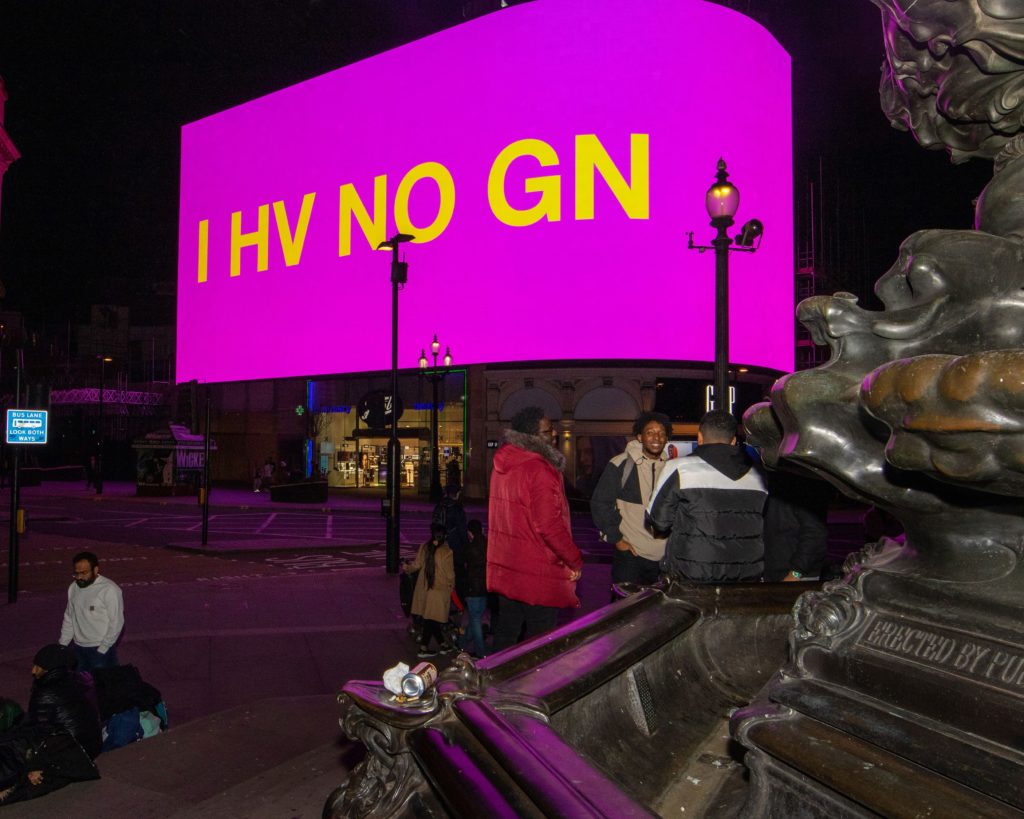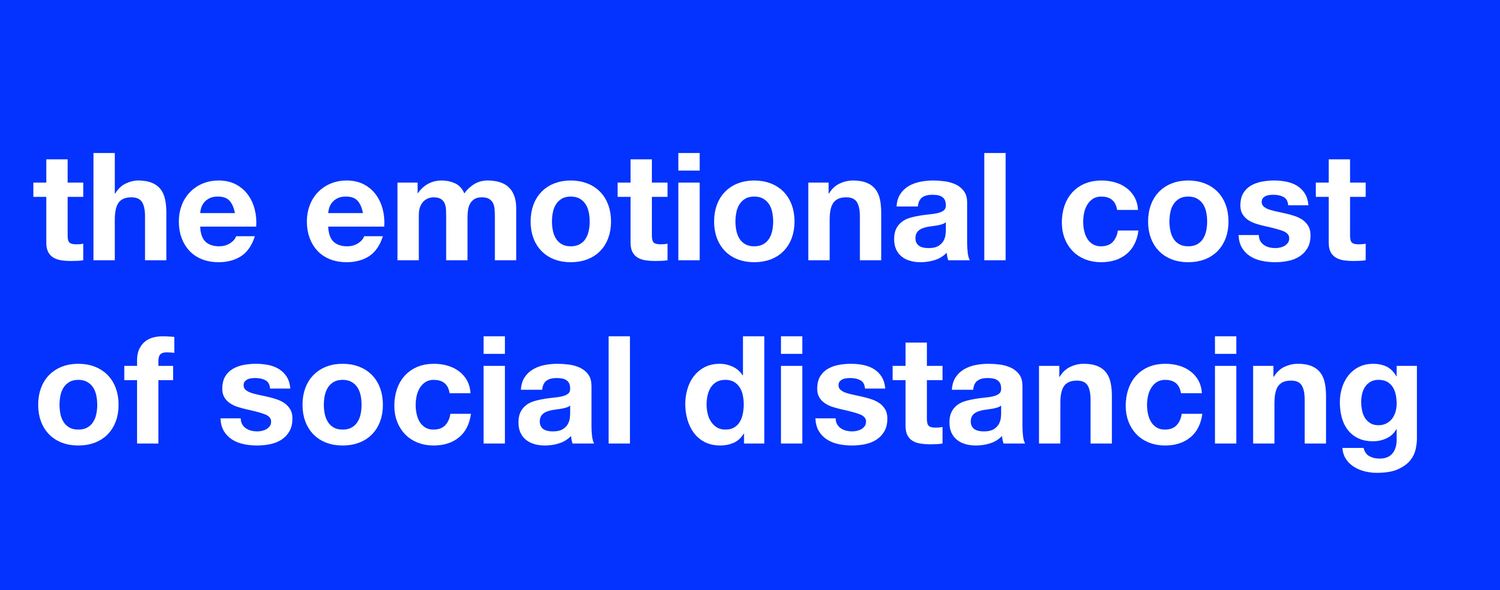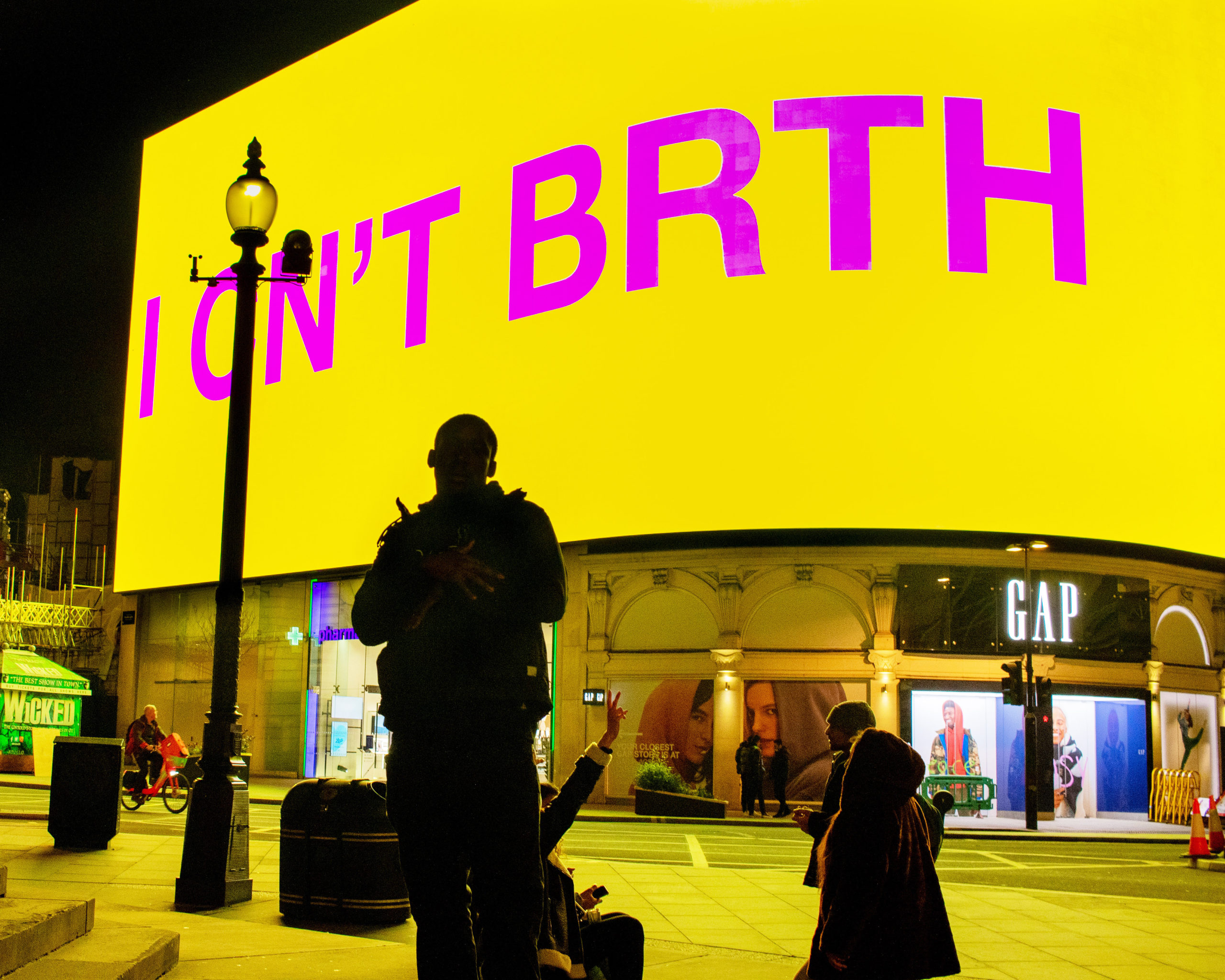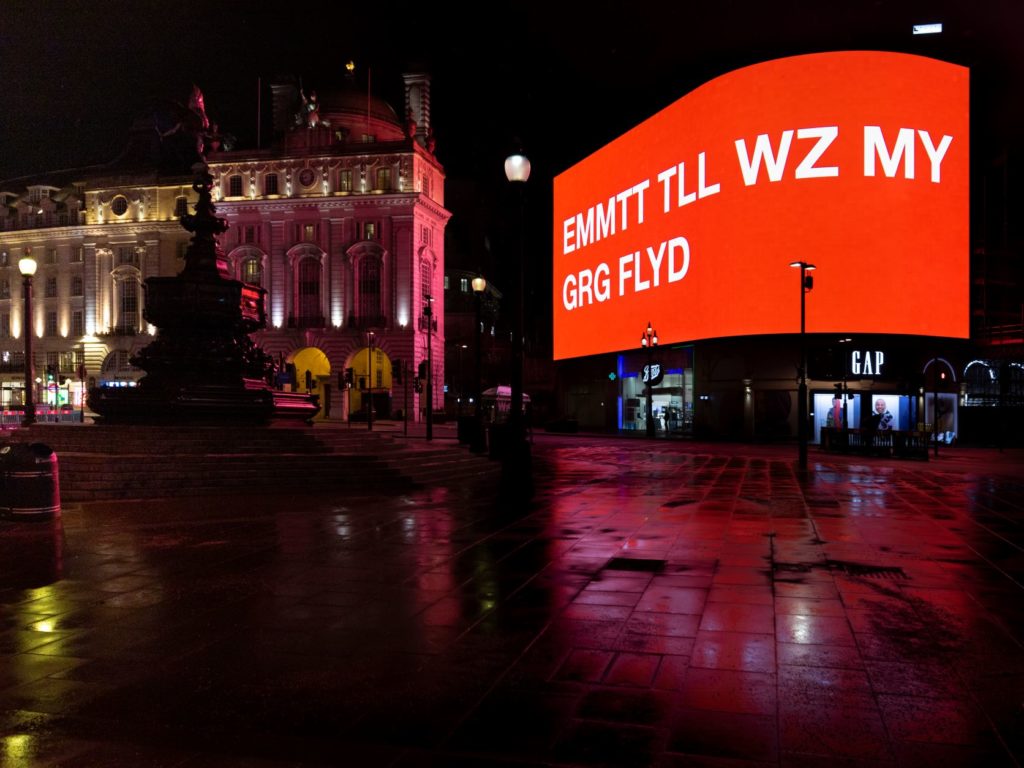Tony Cokes: Choices Can Be Productive
Written by Charlie Colville

“I’m hoping, to some extent, for my work to engage the imagination and produce questions rather than, quote unquote, tell people what they should believe or what they need to know.” – Tony Cokes
February 2021 sees American visual artist Tony Cokes take to the Piccadilly Lights with ‘4 Voices / 4 Weeks’. Cokes has been working in his field since the 1980s and has developed his visual style to incorporate animated text, found images, and solid colours. Using colour theory, coded text, and audio materials, Cokes creates artworks that often examine themes that carry a political resonance and challenge capitalist structures.
A key component of Cokes’ work is the use of ‘cultural fragments’ to reframe ideas and narratives, de-contextualising accepted stories in order to make us question the norms of current society and unearth social injustices.

Tony Cokes will be presenting four films over the four weeks of February, with a different film shown each week. Each video is made up of panels featuring text with words from John Lydon (‘Anger Is An Energy – NGR IZ N NRG’), John Lewis (‘Testament B – 2GTHR U CN RDM TH SL OF TH NATN’), Elijah McClain (‘His Last Words – HS LST WRDZ’), and Judith Butler (‘Mourning Is A Political Act Amid The Pandemic & Its Disparities’) in bright blocks of colour.
Mapping the various reactions to social injustices “from anger to non-violence, from the unfolding of an unjust death to a politicised social mourning”, Cokes’ film series aims to highlight the impact of violence and the struggle for civil rights in modern society.
A way in which Cokes tackles this is through means of readability. Three of the four texts used by Cokes have been translated into a code made up of simple abbreviations and symbols, disrupting their legibility and unsettling known narratives. Cokes’ videos push the audience to concentrate on what is being said and attach their own meanings to what they find, placing the ‘meaning’ of each video in the subjective hands of each individual.
During his time with CIRCA, Cokes has also been in conversation with some of the world’s leaders in art theory and criticism, including Lynton Talbot, Hans Ulrich Obrist, Adrienne Edwards, Cole Moore, and Peter Saville. Each of these conversations are available to read and watch here.
The Audience Chooses
As highlighted on the CIRCA calendar, Tony Cokes’ work has already been discussed extensively in conversations with the artist – and I encourage you to look to these conversations if you’d like to get your teeth into the conceptual framework of his videos.
As such, I wanted to explore Cokes’ work from the perspective of the audience. Cokes has stressed that his role in the artwork is to bring fragments of culture together – regardless of whether they complement or contradict each other – and then leave the scene. In doing so, he allows the audience to put the pieces of the artwork together themselves and formulate their own opinions and conclusions.
As an artist, Cokes was interested in how ideas are processed by individuals and how certain structures could activate specific types of processing. In the case of ‘4 Voices / 4 Weeks’, how the context of a commercial advertising billboard could catch people’s attention and make them feel uneasy when the message they were given wasn’t clear.
In his conversation with Hans Ulrich Obrist, Cokes said that “choices can be productive.” One of the main aspects of Cokes’ work is his implementation of audience autonomy; Coke wants the audience to work to reach their own judgements about the social issues, events, and sources he presents. The variety of ways in which people can react and attach meaning to an artwork is what establishes the artwork’s artistic and social value.
I’ve decided to take this onboard with my approach to this month’s CIRCA offering and will be examining Cokes’ videos from the lens of the audience. I’ve done minimal research outside of the content provided on the CIRCA calendar to help create an authentic experience between myself and the content, with the body of this article focusing on my reactions to the artwork as a whole.
The sensory overload of colour, sound, and text did make the exercise of watching each video difficult as my full concentration was required at all times. The text panels flew across the screen at a fast pace, encouraging you to concentrate on the words in order to catch them – you had to really pay attention if you wanted to find something legible. The coded text only added to this struggle, creating a push and pull between the audience and artwork. Small moments of victory at being able to read a panel quickly shifted to frustration when a lengthier sentence took its place the next second.
This interactive element enabled the audience to create an experience from the artwork that made the moment of understanding all the more valuable.

ANGR IZ N NRG
The first video in the ‘4 Voices / 4 Weeks’ series is a combination of text from John Lydon’s book ‘Anger Is An Energy’ and the song Casino by The Notwist.
In his text, Lydon (of The Sex Pistols and PiL) campaigns for the use of anger to channel productive outcomes. Rather than turn away from emotional responses, the singer highlighted its ability to empathetically resonate and highlight prominent social issues. A point of reference in Lydon’s text was his reaction to news and events surrounding apartheid in South Africa, which evoked an emotional response that urged him to release the song Rise. The importance of this emotional connection is conveyed to be an important motivator for greater social action, which in the case of Lydon was translated into his song writing.
Lydon’s references to apartheid encourages audiences to think back to current race relations and the growth of the Black Lives Matter movement. Conflicts are continually felt and spotlighted – arguably even more during the pandemic. Protests like BLM have been used as a means of channelling the energy of social injustice and expressing the need for change.
The second time the sentence “ANGR IZ N NRG” is shown onscreen is near the end of the video, falling into step with the climax of the song as it enters an instrumental. This reads as a breadcrumb leading to the core message of the video – a resonating statement that we as an audience should acknowledge even if we didn’t grasp or gravitate towards anything else in the text. Anger is capable of being harnessed as something beyond destruction, it is a tool for action.
In contrast, the music was decidedly less optimistic than Lydon’s commentary. The song, Casino by The Notwist, has a sombre and reflective narrative at odds with the energised tone of Lydon’s words. The line “Gambling is a joke” and the references to giving in to reckless temptation illustrate an alternative view of acting rashly that emphasises disappointing results. The repetition of the line “there’s something wrong” near the end of the song only emphasises this, imbuing the atmosphere with an underlying paranoia that throws Lydon’s text into question.
In declaring the shortcomings of relying on an impulsive action – of gambling on a possible outcome in the heat of the moment – it highlighted how there was a risk attached that may make matters worse. However, this is something we have to acknowledge and use to decide if the action is worth the consequence.
Cokes’ use of colour similarly picks up on this contrast. Green and purple are on opposite sides of the colour wheel, and their associations are also at odds with each other. Green is synonymous with calmness and tranquillity, while dark purple is suggested to evoke gloom and sadness. Additionally, the colour green is supposed to improve reading ability, while purple is noted for encouraging feelings of frustration. These subtle details in the video only emphasise the presentation of fragmented ideas and themes, which can create a confusing experience for the viewer.
The video presents two contradicting notions: emotional action and emotional disconnect. It is not specified which of the two is the favoured approach, and the audience therefore feels compelled to choose or make a judgement. Watching the video, it becomes clear how dependent we have become as an audience on a narrator’s direction, especially when put in the context of a commercial advertising space.
Stripping the video down to a simple binary however defeats the complexity of the message. Emotion or reason. Anger or calm. Energy or stagnation. The interweaving of opposing ideas, hopes, and effects makes for an unclear outcome, but looking back it encourages us to see that social situations are objectively not simple. The way we react to certain stimuli produces different results for different people, and our views will fluctuate and develop over time.
Additionally, by using two figures in music who have roots in heavy metal and punk music, Cokes highlights how multiple pathways can be developed from the same starting point; creativity and outlook aren’t limited to one type of output.

TESTAMENT B – 2GTHR U CN RDM TH SL OF TH NATN
Both the music and text of ‘TESTAMENT B – 2GTHR U CN RDM TH SL OF TH NATN’ feature words from the American politician and civil rights activist John Lewis.
The music, Huey Lewis Dub by Deadbeat, takes a sample from one of Lewis’ speeches, which emphasises an approach of non-violence in tackling social issues. Promoting calmness and forgiveness, Lewis encourages his audience to consider how the struggle will be viewed in perspective – he paints the picture of the issues surrounding race relations in America as a long-term endeavour, one that will span lifetimes.
However, the emphasis of a peaceful approach was put at odds with the text. Taken from one of his last written messages before he passed away in 2020, Lewis’ words seem more relevant to the current moment in their reflection on the work of Black Lives Matter. While the line “MLLNS F PPL MTVTD SMPLY X HMN CMPSSN (millions of people motivated simply by human passion)” resonated with the audio’s message of solidarity and optimism, the latter half of the video focuses on why action rather than perseverance has become a necessity.
Lewis highlights this through a retelling of the impact of Emmett Till’s death on him when he was fifteen. Till’s death was another instance in which an innocent black American became the victim of racism. This notion especially resonated all the more when considering today’s injustices: “EMMTT TLL WZ MY GRG FLYD (Emmett Till was my George Floyd).”
The following narrative Lewis creates is unsettling – unsettling because it parallels events that happen today. The fear of being a victim of police brutality, when told in a first-person account, also made the emotional impact of the video a lot stronger. The unease and fear felt is laid out clearly for the audience to see, and the building pace of the panels and the beat of the music seemed to play into an increasing anxiety. This imbued the viewing experience with a charge of horrible anticipation.
“SNCTND TRRR HD TH PWR 2 TRN A SMPL STRLL 2 TH STR 4 SM SKTTLS
OR N NNCNT JG DWN A LNSM CNTRY RD
N2 A NGHTMR
(sanctioned terror had the power to turn a simple stroll to the store for some skittles
or an innocent jog down a lonesome country road
into a nightmare)”
The audience is plunged into a tense atmosphere, especially at the recognition that little has changed in the decades since Lewis’ speech. As the video ends with Lewis’ mention of Elijah McClain, the audience are again brought to the present moment and are confronted by current circumstances of injustice.
In the video, Cokes uses one of the most well-known pairings of contrasting colours: red and blue. Blue, with its relation to cooling properties, calmness, and intellect, was more reflective of the audio’s promotion of non-violence and patience. Red, which is universally associated with fire, action, and blood, highlighted the emotional dimension of the text and its discussion of hate crimes.
Reading and listening to Lewis’ words at the same time presents another contradiction of viewpoints and reactions. The clash of peaceful perseverance and political activism become difficult to consolidate within one instance, making it feel like these options are mutually exclusive.
The tone and messages conveyed were at odds with each other, but it put into perspective how attitudes and opinions can fluctuate with the needs of time. Just because one method works now does not mean it will work in twenty years – deciding what is best during the current time is far more complex than one initiative over another. The two outlooks again illustrated multiple approaches to tackling social issues, reinforcing Cokes’ encouragement of independent reasoning.

HS LST WRDZ
‘HS LST WRDZ’ is the most emotionally impactful of Cokes’ videos. The text conveys the last words of Elijah McClain before his death at the hands of police in 2019. The 23-year-old was stopped, put in a chokehold for fifteen minutes, and sedated; he was not suspected of any crime beforehand. Knowing the outcome of the video – what happens after he stops speaking – culminated in a heart-breaking audience experience.
Following Elijah McClain’s words on the screen gave us a first-hand perspective of how acts of violence impact people of colour. You can feel McClain’s fear and desperation through his words, in particular as he pleads with the officers and apologises despite not knowing why he is being detained. The words “LL I WZ TRING 2 DO / WZ BCM BTTR (all I was trying to do was become better)” speak directly to the audience’s sense of empathy, highlighting the sad reality that McClain can no longer build this future. Despite his aspirations to grow and develop over time, the abrupt conclusion of McClain’s life recalls Lewis’ words: how society is positioned to “CHK 2 DTH TH HPS & DRMS (choke to death the hopes and dreams)” of black communities.
A moment of note in the video is the text: “U R LL PHNMNL (you are all phenomenal)” and “U R BTFL & I LV U (you are beautiful and I love you)”. An unexpected act of kindness in a terrible situation, it only intensified the anguish felt by the audience. It begged the question: How could someone so full of love be a victim of hate?
The text is set against Manic Street Preachers’ Between The Clock and The Bed. The music, rather than act as a contradictory source to the text, emphasised what was playing out onscreen. The line “the simple struggle of survival transforms itself into betrayal” seemed a direct reference to the betrayal of Elijah McClain and other black people who had been violently victimised.
The ending line is sung to a black screen: “we’ve all felt the implications.” The implications of being a person of colour, without context of who that person is or what they do. The ending of the video reinforces this with a repetition of “HS LST WRDZ”, cutting off McClain’s dialogue and therefore insinuating his death.
Colours again support the narrative of the video. While pink relates to universal love and yellow to happiness, the latter is also associated with cowardice and betrayal. The multiple facets of the colour reflected Elijah McClain’s character and experience in that moment: a kind and hopeful person who was let down by the actions of people meant to keep him safe. This visual element of the artwork made the situation feel heavier, with each individual detail leading back to a horrible reality: Elijah McClain was dead.

Witnessing someone’s death – even just in words – encouraged a deep emotional response, and many of the people I have since spoken to about the video found it difficult to watch and shed tears. The confrontational nature of the video, in terms of its ability to upset viewers with its content, becomes a tool to highlight the severity of race-related issues in current society.
Mourning Is A Political Act Amid The Pandemic & Its Disparities
The final video features text taken from an interview with the philosopher and theorist Judith Butler, accompanied by Joy Division’s Exercise One. ‘Mourning Is A Political Act Amid The Pandemic & Its Disparities’ talks explicitly about the current Coronavirus pandemic, which has revealed the shortcomings of current governments and society at large.
Cokes made this the only uncoded video in the series, and therefore the most legible. This made the experience of viewing arguably easier in the sense that there was less emphasis on our ability to pull ideas together or make sense of what was being shown. The music, with its minimal vocals, made the directive to focus on the text more apparent. While Cokes has often said his role isn’t to tell people what to think, it is still insinuated there is a clear message to be received from Butler’s words.
Butler highlights the issues created by current power structures in the post-pandemic era. In particular, how “there are political questions that are linked with the demand for public mourning”, which illustrate the strains on black people, ethnic minorities, incarcerated people, and health services. In doing so, the text is clear in its unveiling of systems that thrive on unjust and unfair practices, in particular capitalist mechanics.
The final lines of the text create a visual narrative to highlight the consequences of such structures: “when loved ones cannot receive the body and the dead body becomes a logistical problem: stacked, counted, transferred, stored.” The widespread devaluing of human lives, to the point where their bodies resemble stock, is a result of the fact that the society we live in is not prepared to look after everyone – only those who are in a position of social or economic privilege.
“[Judith Butler] concisely critiques the social policies and practices made horribly plain by the COVID-19 crisis. I am drawn to Butler’s rigorous framing of the value of mourning in the contemporary world.” – Tony Cokes
As with ‘HS LST WRDS’, the music complements rather than conflicts with the tone of the text. The audio is largely made up of wailing guitars and haunting echoes, emphasising an eeriness that reflects the inhospitable social landscape.
‘Mourning Is A Political Act Amid The Pandemic & Its Disparities’ stood out from the other videos through its societal reflections. Rather than encourage audiences to examine their own involvement and the ways to channel thought, emotions, and aspirations into productive results, this video explains how these isolated acts of violence form a patchwork quilt of social inequalities and hardships that have only become more apparent during the pandemic.
The collaboration between Tony Cokes and CIRCA again illustrated how the production of art is becoming a socially present practice; one that is inclusive of its audience.

‘ANGR IZ N NRG’ and ‘TESTAMENT B –2GTHR U CN RDM TH SL OF TH NATN’ illustrated that there is no defined approach to a situation, and not everything is binary. Complex fragments come together to illustrate the multiple directions we can choose to take, whether we choose angry disruption or calm reflection, peaceful perseverance or collaborative opposition. Taking the time to understand these different perspectives becomes a key development strategy of the artwork, as it is through our engagement that the videos could be activated and cause change.
Confronting the audience with an imperative to reason and judge these resonating voices, rather than give an ultimatum, stripped the relevance of a binary decision. Lynton Talbot said in his conversation with Tony Cokes: “I want anger to be a creative energy as Lydon suggests in the first work, but I fear it is insufficient to achieve what is needed.” This encompasses the lesson learned in Cokes’ first two videos. Approaching social issues is far more complex than choosing disruption or peace, and as illustrated by ‘TESTAMENT B –2GTHR U CN RDM TH SL OF TH NATN’ our view of current circumstances changes over time.
‘HS LST WRDZ’ and ‘Mourning Is A Political Act Amid The Pandemic & Its Disparities’ confront the audience in a different way, illustrating the injustices within current social structures. In their response, the audience are made to feel more than reason, and connect with the human loss of both individuals and masses.
These videos located the struggle for racial equality in the present moment, while encouraging a consideration of the lessons we had learned in the first two videos. Where the first two videos seemed to present the ways in which social issues could be approached, the latter two videos had a greater role in inciting action and bringing the audience directly into the conversation.
This element of inclusivity in Cokes’ artwork was highlighted by the artist’s use of an uncoded version of ‘Mourning Is A Political Act Amid The Pandemic & Its Disparities’, as its directness allowed the audience to watch the video without a predominant focus on deconstructing the legibility of the artwork. In doing so, the message delivered became more powerful and authoritative.
Tony Cokes’ video series with CIRCA is an insightful exercise into autonomous decision-making and social injustice. The freedom to explore modes of action while being confronted with harrowing realities is a heavy case to tackle, but one which Cokes executes without enacting an obtrusive influence on our processing of information. Cokes highlights the necessity to ask questions and move beyond binary thinking, giving the audience a leading role in the artwork.
Created last year as a means of reconnecting the public with art and exhibitions during the pandemic, CIRCA allows for artists to showcase their work in the form of a two-minute video on the Piccadilly Lights, one of London’s most famous landmarks. Every month will see a different artist take to the screen, showcasing videos that expand on their practice and the messages they want to convey to the public.
CIRCA’s videos will be shown at 20:21 GMT every night, breaking the usual stream of commercials and advertisements and creating a live exhibition experience. For those unable to make it to London, each video is streamed and archived on CIRCA’s website.
Charlie Colville is the current Arts Editor for Mouthing Off magazine, an online platform designed to give young people the opportunity to find a new voice – a guttural scream loud enough to arouse fresh ideas, creative thought, and inspire artistic flair.